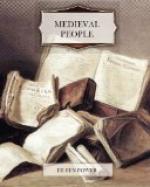Kinsai seems far enough away in all conscience from Venice in the year 1268, and Venice was all unwitting of its existence, far beyond the sunrise. Yet there was in the city of the lagoons that year, watching the same procession of the gilds which Canale watched, a boy who was destined to link them for ever in the minds of men—a lean lad of fourteen, Marco Polo by name, who was always kicking his heels on the quay and bothering foreign sailors for tales of distant lands. He heard all they had to tell him very willingly, storing it up in that active brain of his, for his curiosity was insatiable; but always the tales that he heard most willingly were about the Tartars.
At this time the Tartars were at the height of their power in the West and the East. Tartars ruled at Peking all over northern China, Corea, Mongolia, Manchuria, and Tibet, and took tribute from Indo-China and Java. Tartars were spread over central Asia, holding sway in Turkestan and Afghanistan. The Golden Horde ruled the Caucasus, a large part of Russia, and a piece of Siberia. Tartars held sway in Persia, Georgia, Armenia, and a part of Asia Minor. When the great Mangu Khan died in 1259, one empire lay spread across Asia and Europe, from the Yellow River to the Danube. There had been nothing like it in the world before, and there was nothing like it again, until the Russian Empire of modern times. By 1268 it was beginning to split up into the four kingdoms of China, central Asia, Russia, and Persia, but still it was one people. Now, the attitude of the West to the Tartars at this time was very interesting. At first it feared them as a new scourge of God, like Attila and his Huns; they overran Poland, ravaged Hungary, and seemed about to break like a great flood upon the West, and overwhelm it utterly. Then the tide rolled back. Gradually the West lost its first stupefaction and terror and began to look hopefully towards the Tartars as a possible ally against its age-old foe, the Moslem. The Christians of the West knew that the Tartars had laid the Moslem power low through the length and breadth of Asia, and they knew too, that the Tartars had no very sharply defined faith and were curious of all beliefs that came their way. Gradually the West became convinced that the Tartars might be converted to Christianity, and fight side by side beneath the Cross against the hated Crescent. There grew up the strange legend of Prester John, a Christian priest-king, ruling somewhere in the heart of Asia; and indeed little groups of Nestorian Christians did still survive in eastern Asia at this time.[14] Embassies began to pass between Tartar khans and western monarchs, and there began also a great series of missions of Franciscan friars to Tartary, men who were ethnologists and geographers at heart as well as missionaries, and have left us priceless accounts of the lands which they visited. In the year of grace 1268, much was known about central Asia, for in 1245




